Breastfeeding Tips For Successful Latch
In this post, I have written all the important breastfeeding tips for new moms. Such as breastfeeding latching tips, breastfeeding tips with twins, Breastfeeding Tips For More Milk, Breastfeeding Tips For Breast And Nipples, Breastfeeding Tips For Food And Diet, how to stop breastfeeding tips? And more.
If you are asking “How can I get better at breastfeeding?” then read these beginner breastfeeding tips.
1. Breastfeeding Tips For Good Latch
These tips help you to get a nice latch. It’s important to have a good latch, no matter what position you use to feed your newborn. You need some practice for a good latch. A good latch will make you feel relaxed and help your baby get a good amount of breastmilk.
Follow these steps for a good latch.
- Tickle your baby’s lips with your nipple. This will help the baby open its mouth wide.

- Place your nipple just above the top lip of your newborn. Make sure that the chin of your baby is not tucked into their chest.

- Push the lower lip of your baby away from the base of your breast. . Baby’s lips should be turned outward like a fish. First, your baby should lead into the chin of the breast and then latch onto the breast. Your baby’s tongue should be extended, and your breast should fill your baby’s mouth.

When your baby latches on the tip of your nipple or hurts, gently place a clean finger in your baby’s mouth to remove the latch and try again. Watch the video for correcting a painful latch.
Watch a video story of mothers think about latching on the breast. Also, watch the proper latch video.
What are the signs of a good latch?
There are some signs of a successful latch if you follow these steps:
- It should not hurt.
- Your baby is feeding eight or more times a day after the first 24 hours. Nighttime feedings are to be expected.
- Your baby gets one to three wet diapers a day in her first few days of life. By day four or six, as the milk supply rises, your infant should have five or more wet diapers a day. The pee of the baby should be light yellow.
- Your baby’s head and body should be in a line.
- Your baby’s chin must touch your breast.
- the nipple needs to go over the tongue to the back of the mouth.
- his chin is touching your breast and he can breathe through his nose.
- He starts with short sucks before sucking more slowly and deeply.
- You hear or see swallowing.
- Your baby has returned to his/her birth weight by about two weeks.
Source: (Steps and Signs of a Good Latch | WIC Breastfeeding)
2. Breastfeeding Tips For Pain
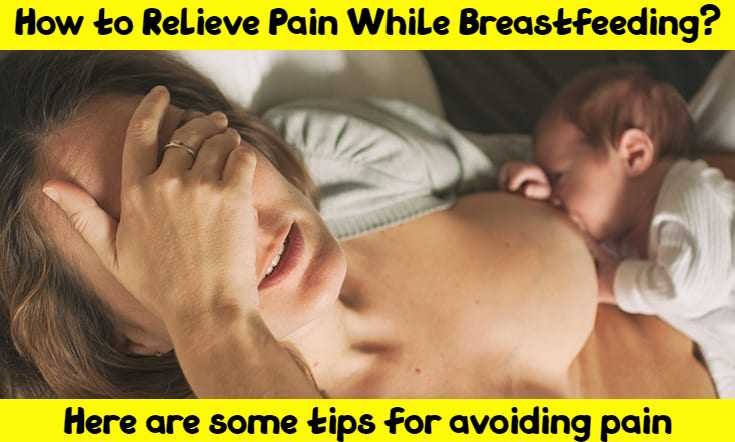
Here are some tips for avoiding pain in the future when dealing with sore breasts or nipples and making yourself more comfortable while your breasts feed.
How to Relieve Pain While Breastfeeding?
- If you have breast pain then use a hand express of breastmilk for 3 to 4 days, this way you can heal your breast.
- Gently rub the swollen region before breastfeeding.
- After breastfeeding use an ice pack or cool compressor on the breast.
- Use different breastfeeding positions to help drain all areas of your breast.
- Use medical-grade lanolin, Lanolin ointment or hydrogel dressings encourage your skin to stay hydrated and protect the healing process without scabbing or crusting. If you are worried about your infant swallowing lanolin or other herbal balms, breast milk can be used to relieve moderate nipple pain.
- Use Correct Latch Techniques for less pain. If you’re positive your nipple pain isn’t caused by broken or sore skin when breastfeeding, you and your baby will need to work on latching. An incorrect latch is stressful for your child and unpleasant for you.
- Start feeding your baby frequently. Feeding your baby sometimes may sound obvious, but it’s important to keep to a daily feeding routine for a few reasons. Firstly, feeding your baby also avoids engorgement. Engorgement occurs when the breasts are so full. They’re going to feel firm and tender, and they will spill.
- For less pain. a baby needs to eat 8 to 12 times every 24 hours during breastfeeding. Schedule a feeding session every 2.5 to 3 hours to keep your baby full and your breasts happy. Expressing a little milk right before feeding will relax the nipples, making it easier for your baby to latch.
- To relieve breastfeeding pain from engorgement, remember to keep a breast pump close by to express any extra milk.
- Use Hot and Cold Therapies.If you find yourself engorged, there are few simple home remedies to relieve your breast pain. It can help to get your milk flowing by applying moist heat to your breasts or taking a wet, 5-minute shower.After feedings, apply a cold compress for extra relief from swelling.
- For 10 minutes, add the compress to your breast and then remove it until the skin is warm to the touch. When required, repeat.
- A cold compress is added after feeding for additional swelling relief.
- For 10 minutes, add the compress to your breast and then remove it until the skin is warm to the touch. When required, repeat.
- Do not use cold compresses before feeding or while your chest is filled. Cold therapy will disrupt the ducts and increase the risk of infection and mastitis.
- Use pain Medication. Discuss with your doctor about breast pain and medication for relief.
- Be sure to contact a doctor or a lactation consultant if you notice that you are regularly unable to feed your baby without discomfort.
Breastfeeding sometimes hurts, but starting breastfeeding pain should only be temporary when you and your baby learn to know each other. If the pain remains, then there are many implications such as bad latching strategies or anatomical defects may be underlying and hinder the baby from eating well. Read more
3. Breastfeeding Tips Sore Nipples
How long will my nipples be sore? Do not worry sore nipples do not last forever. The sore nipple developed for many reasons such as pumping or during breastfeeding. If you have sore nipples problems then Follow these tips to prevent and treat them.
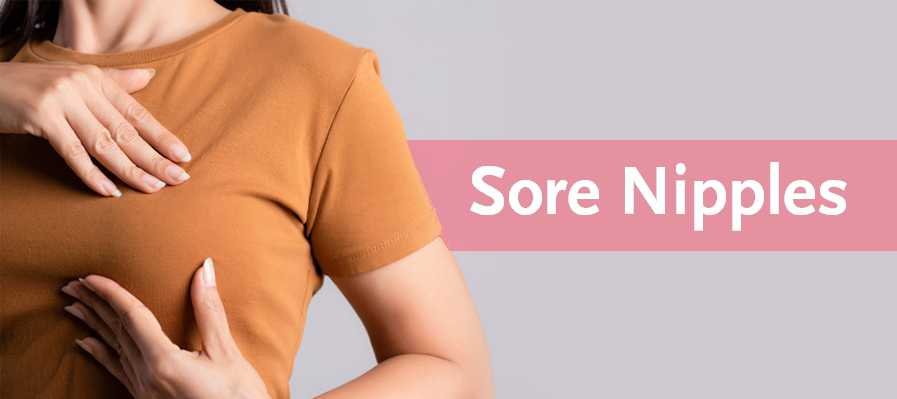
Prevent sore nipples for a better breastfeeding experience:
- First, the key to preventing nipple pain is a good latch. That means you must pull your breast-deep in baby month. I have written “how to give a good latch to a baby” you must read. I have also added images for better understanding.
- You must breastfeed very often and make a baby hunder time table. This will help you in preventing vigorous nursing that may irritate your breasts more.
- You should hand express some breast milk before breastfeed your baby. In this way your breast milk flows faster, and the baby gets better breast milk without getting to work hard. I have written “how to hand express breastmilk best techniques” you should read.
- After breastfeeding you must use your hand to remove the baby mouth from your breast. You just have to use your finger between baby’s gums and holding. it there as you are removing him from your breast to prevent pulling on your nipple. Read more
How To Treat Sore Nipples?
90% of new mothers have nipple soreness. It’s a very normal condition that is temporary, usually goes away in a couple of days. Many mothers will notice nipple soreness peaks on the fifth day of breastfeeding and then overcome it.
Luckily, there are several ways to relieve the pain and make the nipples recover easily! Below we’ll explore some of the causes for nipple pain and some methods to resolve it.
What is the fastest way to heal sore nipples?
Follow these nipple pain remedies:
- Researchers have found that warm, moist heat soothes the nipples and can make the nipples recover more easily. use a clean washcloth or diaper under warm (not hot) water to use moist heat, press the extra water, and put it directly over your breast. Repeat the process as it cools down to room temperature.
- Another natural way to relieve pain and heal is to hand express some amount of milk .gently massage your nipple.
- Reverse pressure softening can be a helpful remedy for sore nipples. if there is a lot of breast swelling (there could be excessive swelling from IV fluids during birth or breast engorgement that makes it hard for the baby to reach or latch onto the nipple). With gentle pressure around the nipple base from one or two fingers, some of the swellings can move away from the nipple.
- Body Positioning: here are the most common breastfeeding positions. If you have pain, consider trying to see if you and your baby can develop a healthier latching condition. read my “breastfeeding positions for new mom”.
Make sure to call your doctor or lactation consultant if you happen to get red nipples after a day or two of your home care.
4. Inverted Nipple Breastfeeding Tips
Do Inverted nipples make breastfeeding difficult? No, Both flat or inverted nipples will not bother with breastfeeding as long as your baby is able to take breast in his or her mouth. heavy sucking of your baby will possibly bring out the nipple.
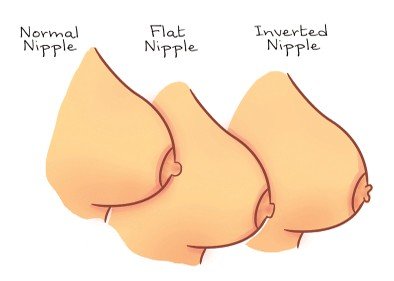
How can I get my baby to latch with an inverted nipple?
There are several techniques you can use to breastfeed if you have inverted nipples.
- During breastfeeding use your hand to roll your nipple between your fingers and try to make it stick out.
- Prepare your breast for latch by Pushing your nipple outside with a ‘V’ or ‘C’ shape in your breast right above your areola.
- You can also use an ice cube. Briefly touch the nipple with an ice cube or cold compress to make it erect.
If these tips do not work and the baby is still struggling for breastfeed. Then you should use a nipple shield. This is a thin, flexible piece of silicone, shaped like a nipple, with holes in the tip for your milk to pass through.
5. Breastfeeding Tips For Large Breasts
How to latch a baby when you have large breasts? Do not worry, there are some breastfeeding positions that will be easier than others. Follow the positions if you have a large breast.
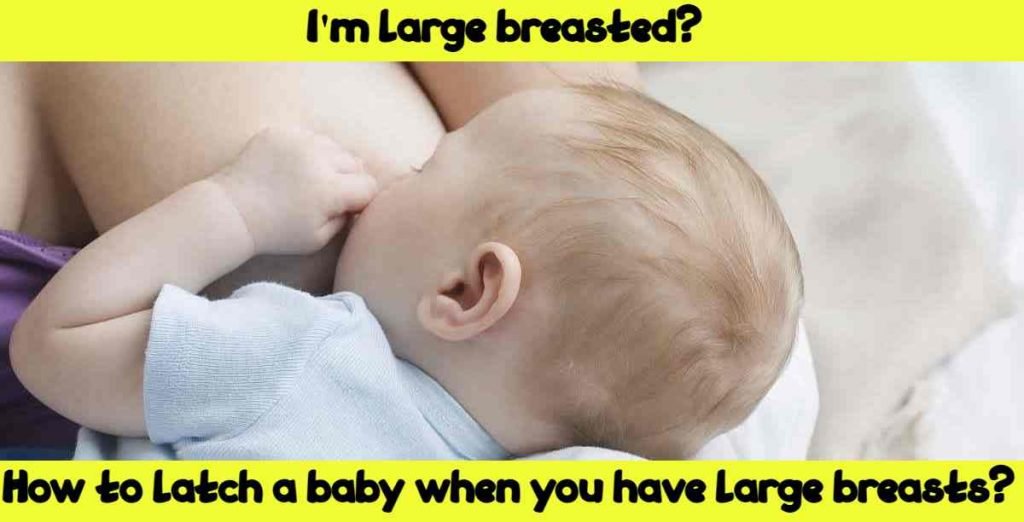
Side lying
This will help you see the latching process and observe your baby during feeding. In this position many find it more convenient to treat their breasts. Besides that, it would be better to lay down on the back and shoulders and neck to support you in a reclining position. I have written a complete guide on how to breastfeed baby in side line position you must read.
Football/clutch
In this feeding position you can easily control the baby body during breastfeeding.
- You had a C-section.
- You are breastfeeding twins.
- You have large breasts.
- Your nipples are flat or inverted.
- Your milk let-down is strong.
- Your baby likes to feed upright. This position may help babies with reflux.
- This is how you and your baby are comfortable breastfeeding.
I have written a complete guide on how to breastfeed baby in football hold position you must read.
Laid back breastfeeding (biological nurturing)
This position gives your baby a full way to get breastmilk. babies open their mouth widely to latch themselves onto the breast. Baby back, shoulders are in good position.You’d like a relaxed, baby-led approach. This is how you and your baby are comfortable breastfeeding.
I have written a complete guide on how to breastfeed a baby in a laid back breastfeeding position you must read.
What feeding positions work if I’m large breasted?
Use these three feeding positions: side lying, football hold, laid back breastfeeding positions to feed your newborn baby.
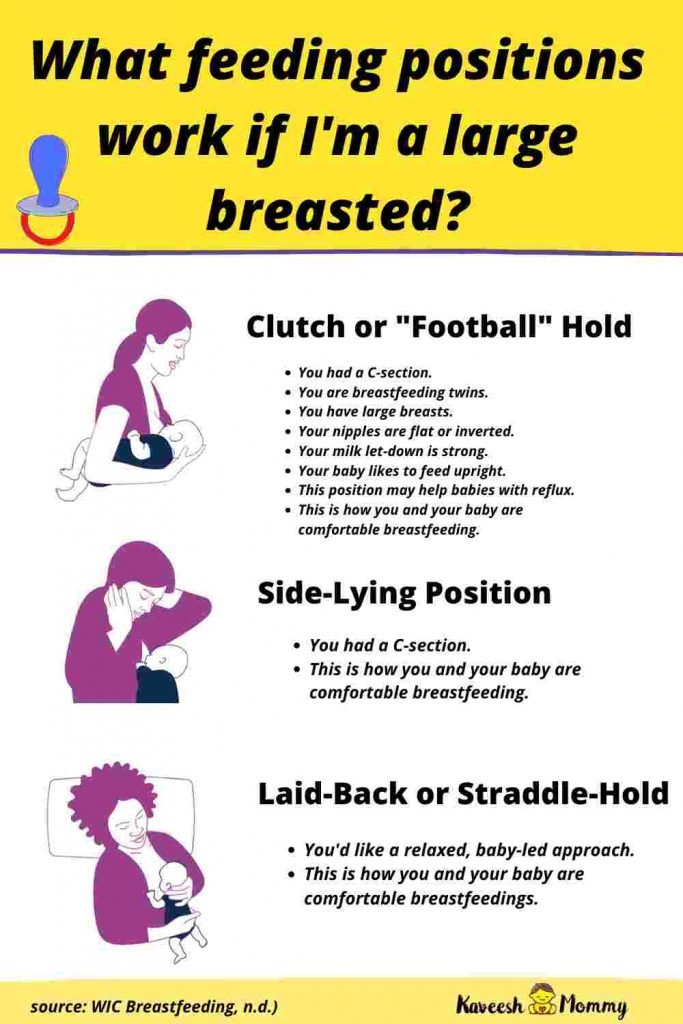
Watch the video for better understanding if you have a large breast.
How to Breastfeed When You Have Large Nipples?
Yes, you can breastfeed your baby if you have large nipples. Your newborn baby can easily suck milk whatever size and shapes your nipples you have.
Your baby may not be getting a good amount of breastmilk if you just lie on your nipples. You need to learn a few tricks to breastfeed your newborn.
Follow these tips:
- Wait for baby response: Wait until your child’s mouth is very wide open before you latch the baby on to your breast. They will not be able to get the nipple and any of the surrounding areola into his or her mouth if they do not open wide enough.
- Express some breast milk by hand: If your breasts are full, squeeze some of your breast milk out of your hand before you start breastfeeding. A baby is difficult to latch on to a full breast. Your baby will be able to latch on more and suck in some of your areola if you remove some of the breast milk and manually rub your breast.
- Try different breastfeeding positions: you should try three breastfeeding positions first, football hold, second, laid back hold, third, side lying position. These positions will help you good latch your baby mouth. I have also explained these three positions above in this post.
- Try nipple shield: For a small newborn or a premature baby, nipple shields make it easier to latch on to the breast. They can prevent sore nipples as well. This device can be very helpful when used under the direct supervision of a professional.
If all these tips and home remedies are not working then you should try breast and formula or combination of both. You should also discuss consultants or doctors.
Conclusion
5 Breastfeeding Holds to Try | WIC Breastfeeding. (n.d.). Wic Breastfeeding.Fns.Usda.Gov. https://wicbreastfeeding.fns.usda.gov/5-breastfeeding-holds-try
Breastfeeding FAQs: Pain and Discomfort (for Parents) – Nemours KidsHealth. (n.d.). Kidshealth.org. https://kidshealth.org/en/parents/breastfeed-discomfort.html#:~:text=Put%20ice%20packs%20or%20cool
Espinal, C. (2019, September 24). 5 Tips for Breastfeeding Pain Relief – How to Avoid the Pain | New Parent. New Parent – Essential Guide for New Parents, Moms, and Baby Products. https://newparent.com/baby/5-tips-for-breastfeeding-pain-relief/
Nipple Pain Remedies. (2015, June 26). American Pregnancy Association. https://americanpregnancy.org/healthy-pregnancy/breastfeeding/nipple-pain-remedies-12015/
Steps and Signs of a Good Latch | WIC Breastfeeding. (2019). Usda.Gov. https://wicbreastfeeding.fns.usda.gov/steps-and-signs-good-latch



